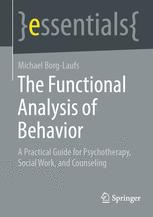The term “stimulus” refers to the stimulus immediately preceding a behavior. In a somewhat less learning-theoretical formulation, we could also speak here of the “situation” in which a behavior is exhibited. Stimuli can be of very different kinds. On the one hand, these are external events, e.g. the mother asks her child to start homework, or the husband makes a derogatory comment about his wife’s new hairstyle, or a dog comes running towards someone, and so on. These are all external stimuli (Se). On the other hand, events or conditions within the person can also be what is called an internal stimulus (Si), such as emerging boredom or fatigue or a certain feeling or pain, etc. Since specific behaviors are not exhib- ited all the time, the search here must be for a stimulus that actually immediately precedes the behavior on a frequent basis. It is not useful to define a permanent condition as a stimulus. For example, a father might say. “Well, my son has these limitations all the time because of his chronic illness, so that certainly triggers his aggressive behavior.” Now would the child’s chronic illness, or would the result- ing limitations, now be a stimulus in the sense of functional behavior analysis? No, because the son, as can be inferred from the father’s further statements (and as is to be expected), does not exhibit the aggressive behavior (screaming, hitting) continuously, but a few times a day. The rest of the time, however, the illness and the restrictions are also present, but do not trigger the aggressive behavior. As a therapist or counsellor, it is therefore necessary to look for a more specific stim- ulus that precedes the respective aggressive behavior episodes. This can be an external event that has not yet been noticed as a trigger (e.g. a call from a school friend who tells about his activities), but it can also be an internal event, such as a certain triggering thought or a physical pain that only occurs temporarily
چکیده فارسی
اصطلاح "محرک" به محرک بلافاصله قبل از یک رفتار اشاره دارد. در فرمولبندی نظری-تئوری کمی کمتر، میتوانیم در اینجا از «وضعیت» که در آن یک رفتار نشان داده میشود صحبت کنیم. محرک ها می توانند انواع بسیار متفاوتی داشته باشند. از یک طرف، اینها رویدادهای خارجی هستند، به عنوان مثال. مادر از فرزندش می خواهد که مشق شب را شروع کند، یا شوهر در مورد مدل موی جدید همسرش اظهار نظر تحقیر آمیزی می کند، یا سگی به سمت کسی می دود و غیره. اینها همه محرک های خارجی (Se) هستند. از سوی دیگر، رویدادها یا شرایط درون فرد نیز میتواند محرک درونی (Si) باشد، مانند بروز کسالت یا خستگی یا احساس یا درد خاص و غیره. از آنجایی که رفتارهای خاص همیشه نشان داده نمیشوند. ، جستجو در اینجا باید برای محرکی باشد که در واقع بلافاصله بر اساس رفتار مکرر پیش از آن باشد. تعریف یک وضعیت دائمی به عنوان یک محرک مفید نیست. مثلاً یک پدر ممکن است بگوید. "خب، پسر من همیشه به دلیل بیماری مزمنش این محدودیت ها را دارد، به طوری که مطمئناً باعث رفتار پرخاشگرانه او می شود." حال آیا بیماری مزمن کودک، یا محدودیت های ناشی از آن، اکنون محرکی به معنای تحلیل رفتار عملکردی خواهد بود؟ خیر، زیرا پسر، همانطور که از اظهارات بعدی پدر استنباط می شود (و همانطور که انتظار می رود)، رفتار پرخاشگرانه (جیغ زدن، ضربه زدن) را به طور مداوم از خود نشان نمی دهد، بلکه چند بار در روز است. با این حال، در بقیه زمانها، بیماری و محدودیتها نیز وجود دارد، اما باعث بروز رفتار پرخاشگرانه نمیشود. بنابراین، به عنوان یک درمانگر یا مشاور، لازم است به دنبال یک محرک خاص تری باشید که قبل از اپیزودهای رفتار پرخاشگرانه مربوطه باشد. این می تواند یک رویداد خارجی باشد که هنوز به عنوان محرک مورد توجه قرار نگرفته است (مثلاً تماس یک دوست مدرسه ای که در مورد فعالیت های خود می گوید)، اما همچنین می تواند یک رویداد داخلی باشد، مانند یک فکر تحریک کننده خاص یا یک درد فیزیکی که فقط به طور موقت رخ می دهد
ادامه ...
بستن ...
Care must be taken in exploring the stimulus to identify it as concretely as possible. For example, parents might initially report that their daughter’s problem behavior always occurs when the homework needs to be done. However, more detailed inquiries may reveal that the daughter does her homework without major problems when the father asks her to do it, while the problem behavior occurs regularly when the mother gives the prompt. The stimulus then is not the home- work situation, but the prompting by the mother. All these sharpenings help to plan the intervention specifically as well, as we will see later. Often a single stimulus can be identified that regularly precedes the problem behavior. Occasionally, however, a combination of stimuli is involved. For exam- ple, imagine a child with separated parents who, when he feels bored (S i) and is alone with his father (Se), goes on a rampage through the apartment and gets into all kinds of mischief (R). The father reinforces the behavior by starting a wild game with his daughter, which defeats the boredom (C). If, on the other hand, the girl feels boredom when she is with her mother, she does not exhibit the behavior. This is because she has experienced that her mother then sends her to her room, where she only feels more boredom. So in this example, two stimulus conditions (boredom and father’s presence) must come together. Only one of the two would not result in the behavior. If she feels boredom and the father is not there, romp- ing around the apartment does not help. If she is with the father but is not bored, there is no reason to romp around the apartment either
ادامه ...
بستن ...










